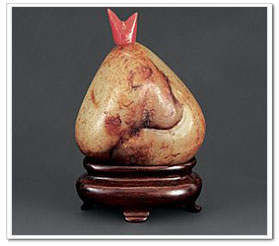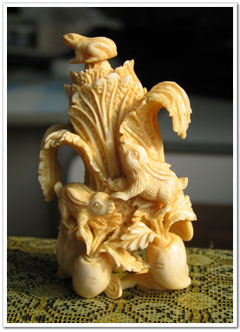 In terms of China's history, Chinese snuff bottles are a relatively recent development. Tobacco reached China toward the end of the 16th Century AD, and it seems likely that snuff was available by the mid-seventeenth century. Customs records show that by 1685 snuff was entering China, although it could have been used even earlier. Using snuff was largely a habit of the upper classes. The Jesuits introduced it at court and its use became common among members of royalty, rich landlords and merchants.
In terms of China's history, Chinese snuff bottles are a relatively recent development. Tobacco reached China toward the end of the 16th Century AD, and it seems likely that snuff was available by the mid-seventeenth century. Customs records show that by 1685 snuff was entering China, although it could have been used even earlier. Using snuff was largely a habit of the upper classes. The Jesuits introduced it at court and its use became common among members of royalty, rich landlords and merchants.
Beijing was the center of snuff usage in China. Documents show that snuff was being manufactured in Beijing from the early 18th Century. Mint, camphor and jasmine were and still are added to snuff in China.
The Chinese believed that snuff possessed medicinal qualities. Its use was said to aid in digestion, dispel colds, cure migraine, sinus problems and tooth pain, relieve throat trouble, cause sweats and counter asthma and constipation.
It was not until the eighteenth century that snuff bottles began to be made in large quantities. They were small enough to fit in the palm of the hand. Usually there was a small spoon affixed to the stopper and the cap was a hemispherical piece of jade. Snuff bottles probably evolved from the small medicine bottles from an earlier period. Snuff bottles often have either the maker's name or the date but rarely both. The earliest dated piece is 1653. Many of the dates are inaccurate. A large number carry the mark of the Qianlong reign, but most of these were really made during the reign of Tao Kuang (1821-1850) or later. Bottles with interior painting were first made in the latter part of the nineteenth century.
 Snuff bottles are made of a wide variety of materials, coral, ivory, jade, jadeite, mother of pearl, lapis lazuli, quartz, malachite, agate, and turquoise as well as gold, silver and other exotic materials. Despite the number of exotic materials to choose from, glass is the most popular and most surviving models are made from this material. The Chinese cut and polished the glass like a precious stone. When metal oxides were added, the subsequent glass became an exquisite glass sculpture. The glass for these works generally originated in Shantung, although the cutting itself was done in Beijing.
Snuff bottles are made of a wide variety of materials, coral, ivory, jade, jadeite, mother of pearl, lapis lazuli, quartz, malachite, agate, and turquoise as well as gold, silver and other exotic materials. Despite the number of exotic materials to choose from, glass is the most popular and most surviving models are made from this material. The Chinese cut and polished the glass like a precious stone. When metal oxides were added, the subsequent glass became an exquisite glass sculpture. The glass for these works generally originated in Shantung, although the cutting itself was done in Beijing.
The most charming and truly fascinating Chinese snuff bottles are those with paintings on the interior walls. These are painted from the inside after the inside of the bottle is coated with iron oxide mixed with water. This creates a milky white surface suitable to take the subsequently applied paint. The scenes were usually landscapes, flowers, people or animals. These are truly works of art.
One of the most famous painters of these scenes was Ma Shao-hsuan, who worked from 1895 to about the mid 1920s. Other famous artists who worked with snuff bottle painting were Chou-Lo-yuan and Yeh Chung-san. By the start of World War II in China, most of the best artists had ceased work. The majority of bottles in present day tourist markets, of course, are of contemporary origin and in general the quality of these paintings is vastly inferior to earlier works.

